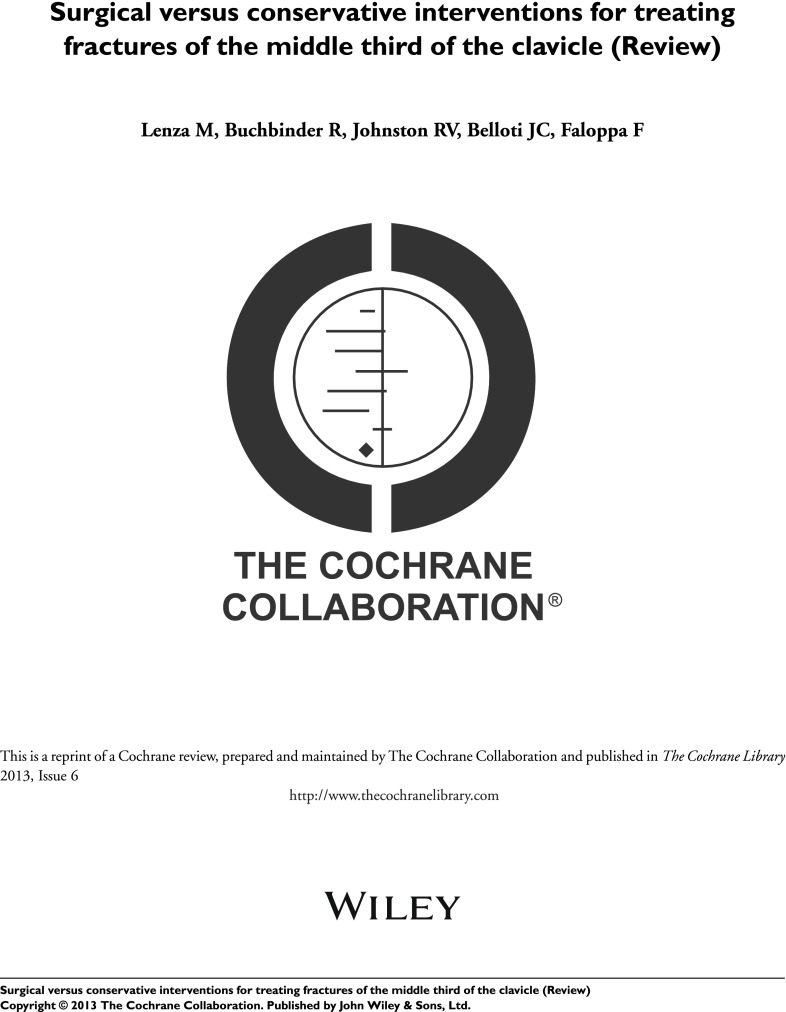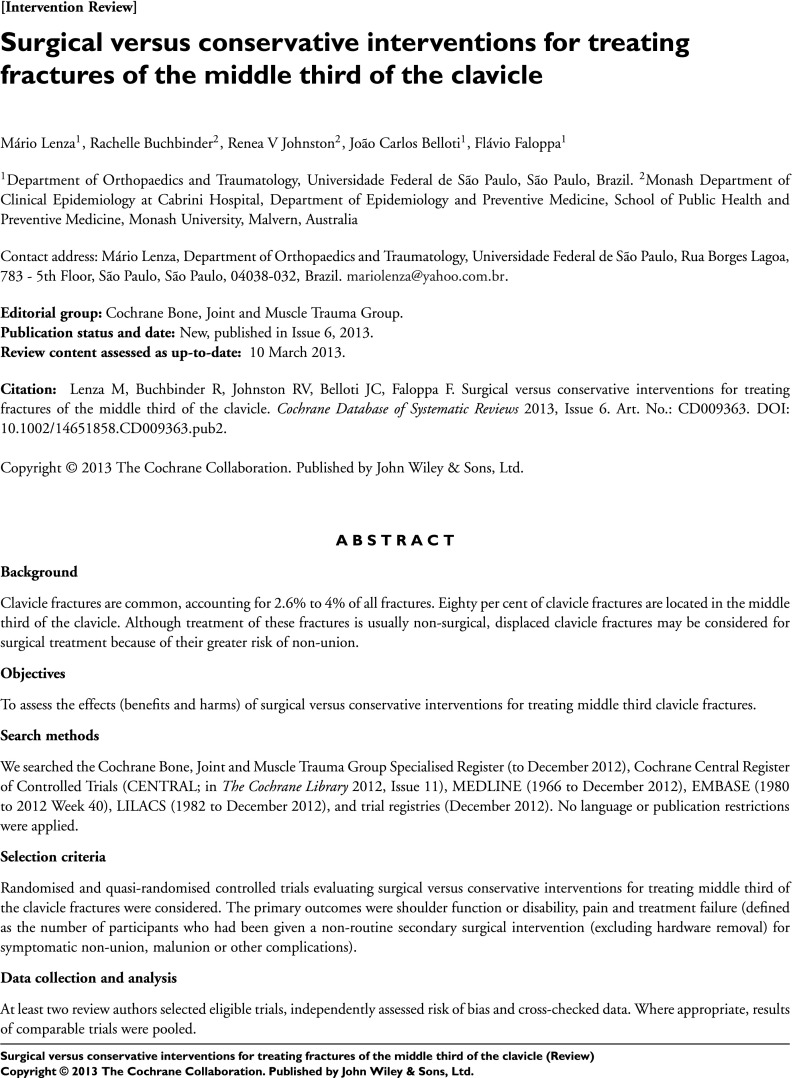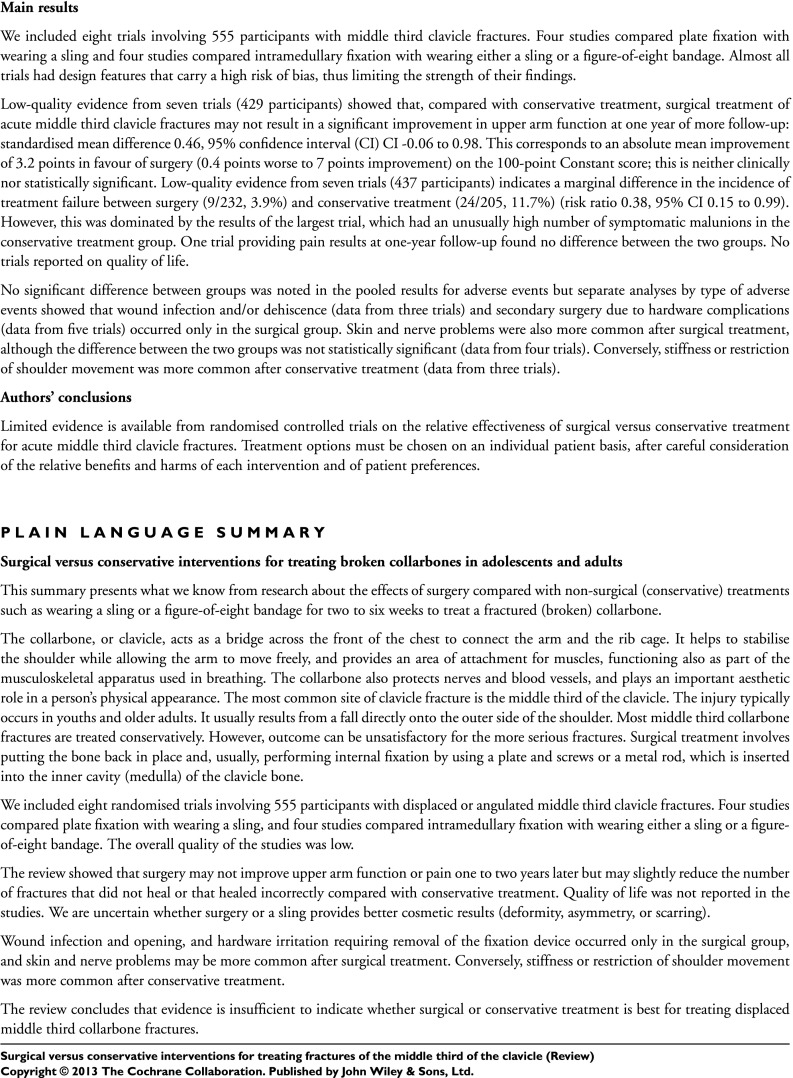Importance of the Topic
Middle-third clavicle fractures are among the most common upper extremity injuries managed by orthopaedic surgeons [5]. They most frequently result from high-energy or athletic trauma in young males, but they also occur as insufficiency fractures following low-energy falls in the elderly [11]. Historically, the nonunion rate with conservative management was thought to be less than 1%. Malunion was considered unlikely to influence function, and patients with these injuries were expected to heal uneventfully [10, 15]. A 2009 Cochrane Review [7] comparing sling immobilization and figure-of-eight bandage treatment found no significant advantage for either method.
Several recent prospective studies reported nonunion rates of 15% to 20% and greater residual weakness, dysfunction, and dissatisfaction in patients with displaced middle-third clavicle fractures that were treated nonoperatively [2, 8]. Symptomatic malunion has been identified as a unique clinical entity with characteristic orthopaedic, neurologic, and cosmetic deficits [13]. Operative treatment with plates and screws or intramedullary devices may lead to higher scores on disease-specific functional outcome instruments, but there are risks for infection, wound breakdown, and hardware irritation requiring subsequent removal [2]. In order to fully inform patients and clinicians about the benefits and harms of treatment, this Cochrane Review considered the results of all published randomized and quasirandomized clinical trials comparing surgical and nonoperative management for displaced or angulated middle third clavicle fractures.
Upon Closer Inspection
Seven of the eight trials reported functional outcomes using either the Constant score or the DASH. The Constant score is a 100-point scoring system in which 35 points are derived from patient self-assessment [3], and the DASH is a 30-item patient-administered instrument divided into physical function, symptoms, and social domains [4]. Neither is validated as a disease-specific outcome measure for patients with clavicle fractures, but they are both commonly used in studies of upper extremity trauma [17]. This Cochrane Review did not find differences in functional outcomes between the groups treated surgically or nonoperatively.
The search strategy identified all published randomized and quasirandomized controlled trials. Randomization balances the known and unknown determinants of outcome between groups in order to minimize selection bias and differential treatment bias [1]. Quasirandomized methods of allocation such as by hospital chart number, alternation, or day of birth, may lead to exaggerated or inaccurate study results [1]. Of the eight included trials, five did not adequately report their methods of allocation, and four did not describe whether allocation was concealed. Still, the authors included a sensitivity analysis that found no change in the primary pooled estimates of the effect of treatment when the lower-quality trials were excluded.
Take-Home Messages
Given that the majority of displaced middle-third clavicle fractures affect young active males, early return to function is of substantial socioeconomic importance [12]. Most patients in this meta-analysis experienced similar functional outcomes regardless of whether they were treated operatively or nonoperatively, which contrasts with a similar recent meta-analysis that found marginally superior long-term outcomes with operative treatment [9]. We suspect the no-difference finding in the current Cochrane Review, in contrast to that earlier study [9], can likely be explained by varying definitions of clinical significance and the inclusion of three additional trials. Neither meta-analysis incorporated a validated threshold of clinical importance, but both acknowledged that small statistically significant treatment effects may not be patient-important. The three additional trials had lower rates of symptomatic malunions in their nonoperative groups, which may have relatively improved the pooled functional outcome scores for non-operative treatment in this meta-analysis.
To date, all of the randomized trials have found that 15% to 20% of patients develop nonunion with nonoperative management, and that malunions are common with that approach, in contrast to nearly consistent achievement of union and a low frequency of major complications with operative treatment [9, 14]. Nonetheless, this meta-analysis failed to identify any advantages with operative management using validated functional outcome instruments. There may be some patients who would benefit from surgery. However, it remains unclear whether certain fracture characteristics like shortening, comminution, or acute scapular winging caused by translation of the distal fragment (medially, inferiorly, and anteriorly) can reliably predict patient-important functional outcomes following nonoperative management [6, 13, 16]. Factors such as concomitant polytrauma, functional demands, or cultural responses to pain and disability could potentially influence whether a surgical or nonoperative approach is more likely to result in a satisfied patient. This Cochrane Review provides critical evidence-based insight into the management of displaced middle-third clavicle fractures, and clinicians must carefully integrate these findings with patient preferences during decision-making.
Appendix
Footnotes
A Note from the Editor-in-Chief: We are pleased to present to readers of Clinical Orthopaedics and Related Research® the next installment of Cochrane in CORR®, a regular feature. In this column, we will identify an abstract originally published in The Cochrane Library that we think is especially important, and Dr. Nathan Evaniew and his colleagues will provide expert perspective on it.
(Lenza M, Buchbinder R, Johnston RV, Belloti J, Faloppa F. Surgical versus conservative interventions for treating fractures of the middle third of the clavicle. Cochrane Database of Systematic Reviews 2013, Issue 6. Art. No.: CD009363. DOI: 10.1002/14651858.CD009363.pub2.)
Copyright © 2013 The Cochrane Collaboration. Published by John Wiley & Sons, Ltd. Reproduced with permission.
One of the authors (MDM) certifies that he, or a member of his immediate family, has or will receive payments or benefits, during the study period, an amount in excess of USD 10,000–100,000 from Stryker (Mahwah, NJ, USA).
One of the authors (ES) certifies that he, or a member of his immediate family, has or will receive payments or benefits, during the study period, an amount in excess of USD 10,000–100,000 from Stryker (Mahwah, NJ, USA).
All ICMJE Conflict of Interest Forms for authors and Clinical Orthopaedics and Related Research ® editors and board members are on file with the publication and can be viewed on request.
The opinions expressed are those of the writers, and do not reflect the opinion or policy of CORR ® or the Association of Bone and Joint Surgeons®.
Cochrane Reviews are regularly updated as new evidence emerges and in response to feedback, and The Cochrane Library (http://www.thecochranelibrary.com) should be consulted for the most recent version of the review.
This Cochrane in CORR® column refers to the abstract available at: DOI: 10.1002/14651858.CD009363.pub2.
References
- 1.Bhandari M, Guyatt GH, Swiontkowski MF. User’s guide to the orthopaedic literature: How to use an article about a surgical therapy. J Bone Joint Surg Am. 2001;83-A:916–922. [DOI] [PubMed]
- 2.Canadian Orthopaedic Trauma Society Nonoperative treatment compared with plate fixation of displaced midshaft clavicular fractures. A multicenter, randomized clinical trial. J Bone Joint Surg Am. 2007;89:1–10. doi: 10.2106/JBJS.F.00020. [DOI] [PubMed] [Google Scholar]
- 3.Constant CR, Gerber C, Emery RJ, Søjbjerg JO, Gohlke F, Boileau P. A review of the constant score: Modifications and guidelines for its use. J Shoulder Elbow Surg. 2008;17:355–361. doi: 10.1016/j.jse.2007.06.022. [DOI] [PubMed] [Google Scholar]
- 4.Hudak PL, Amadio PC, Bombardier C. Development of an upper extremity outcome measure: The DASH (disabilities of the arm, shoulder and hand) [corrected]. the upper extremity collaborative group (UECG) Am J Ind Med. 1996;29:602–608. doi: 10.1002/(SICI)1097-0274(199606)29:6<602::AID-AJIM4>3.0.CO;2-L. [DOI] [PubMed] [Google Scholar]
- 5.Kim W, McKee MD. Management of acute clavicle fractures. Orthop Clin North Am. 2008;39:491, 505, vii. [DOI] [PubMed]
- 6.Ledger M, Leeks N, Ackland T, Wang A. Short malunions of the clavicle: An anatomic and functional study. J Shoulder Elbow Surg. 2005;14:349–354. doi: 10.1016/j.jse.2004.09.011. [DOI] [PubMed] [Google Scholar]
- 7.Lenza M, Belloti JC, Andriolo RB, Gomes Dos Santos JB, Faloppa F. Conservative interventions for treating middle third clavicle fractures in adolescents and adults. Cochrane Database Syst Rev. 2009;CD007121. [DOI] [PubMed]
- 8.McKee MD, Pedersen EM, Jones C, Stephen DJ, Kreder HJ, Schemitsch EH, Wild LM, Potter J. Deficits following nonoperative treatment of displaced midshaft clavicular fractures. J Bone Joint Surg Am. 2006;88:35–40. doi: 10.2106/JBJS.D.02795. [DOI] [PubMed] [Google Scholar]
- 9.McKee RC, Whelan DB, Schemitsch EH, McKee MD. Operative versus nonoperative care of displaced midshaft clavicular fractures: A meta-analysis of randomized clinical trials. J Bone Joint Surg Am. 2012;94:675–684. doi: 10.2106/JBJS.J.01364. [DOI] [PubMed] [Google Scholar]
- 10.NEER CS,2nd Nonunion of the clavicle. J Am Med Assoc. 1960;172:1006–1011. doi: 10.1001/jama.1960.03020100014003. [DOI] [PubMed] [Google Scholar]
- 11.Nowak J, Mallmin H, Larsson S. The aetiology and epidemiology of clavicular fractures. A prospective study during a two-year period in Uppsala, Sweden. Injury. 2000;31:353–358. doi: 10.1016/S0020-1383(99)00312-5. [DOI] [PubMed] [Google Scholar]
- 12.Pearson AM, Tosteson AN, Koval KJ, McKee MD, Cantu RV, Bell JE, Vicente M. Is surgery for displaced, midshaft clavicle fractures in adults cost-effective? results based on a multicenter randomized, controlled trial. J Orthop Trauma. 2010;24:426–433. doi: 10.1097/BOT.0b013e3181c3e505. [DOI] [PMC free article] [PubMed] [Google Scholar]
- 13.Ristevski B, Hall JA, Pearce D, Potter J, Farrugia M, McKee MD. The radiographic quantification of scapular malalignment after malunion of displaced clavicular shaft fractures. J Shoulder Elbow Surg. 2013;22:240–246. doi: 10.1016/j.jse.2012.04.011. [DOI] [PubMed] [Google Scholar]
- 14.Robinson CM, Goudie EB, Murray IR, Jenkins PJ, Ahktar MA, Read EO, Foster CJ, Clark K, Brooksbank AJ, Arthur A, Crowther MA, Packham I, Cheeser TJ. Open reduction and plate fixation versus nonoperative treatment for displaced midshaft clavicular fractures: A multicenter, randomized, controlled trial. J Bone Joint Surg Am. 2013;95:1576–1584. doi: 10.2106/JBJS.L.00307. [DOI] [PubMed] [Google Scholar]
- 15.Rowe CR. An atlas of anatomy and treatment of midclavicular fractures. Clin Orthop Relat Res. 1968;58:29–42. doi: 10.1097/00003086-196805000-00006. [DOI] [PubMed] [Google Scholar]
- 16.Wick M, Muller EJ, Kollig E, Muhr G. Midshaft fractures of the clavicle with a shortening of more than 2 cm predispose to nonunion. Arch Orthop Trauma Surg. 2001;121:207–211. doi: 10.1007/s004020000202. [DOI] [PubMed] [Google Scholar]
- 17.Wright RW, Baumgarten KM. Shoulder outcomes measures. J Am Acad Orthop Surg. 2010;18:436–444. doi: 10.5435/00124635-201007000-00006. [DOI] [PubMed] [Google Scholar]





